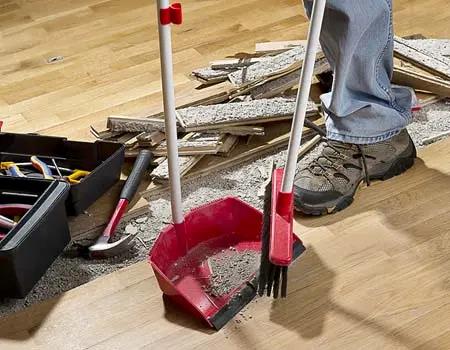Construction projects are exhilarating ventures that culminate in tangible results. However, once the dust settles (literally), the focus shifts to post-construction cleaning. This crucial phase can make or break the overall impression of the project. A meticulously cleaned site not only ensures safety but also enhances the aesthetics and functionality of the newly constructed space. Post-construction cleaning is crucial for ensuring that a newly constructed or renovated space is safe, presentable, and ready for occupancy or immediate use.
Here are the top 10 tips for achieving post-construction cleaning success.
1. Plan Ahead: Successful post-construction cleaning starts long before the project’s completion. Integrate cleaning considerations into the initial project plan. Identify high-traffic areas, delicate surfaces, and specialized cleaning requirements. Collaborate with contractors and cleaning professionals to establish a comprehensive cleaning timeline aligned with the construction schedule.
2. Safety First: Prioritize safety throughout the cleaning process. Construction sites harbor various hazards, including sharp objects, debris, and chemical residues. Provide cleaning crews with appropriate personal protective equipment (PPE), such as gloves, goggles, and hard hats. Conduct thorough safety briefings to familiarize workers with potential risks and safe cleaning practices.
3. Divide and Conquer: Break down the cleaning tasks into manageable segments. Divide the site into zones based on proximity, functionality, and surface types. Allocate cleaning teams to each zone and equip them with the necessary tools and supplies. Establish clear communication channels to coordinate efforts and address any emerging challenges promptly.
4. Use the Right Equipment: Different surfaces demand different cleaning techniques and products. Invest in high-quality cleaning equipment and supplies designed for post-construction cleaning tasks. Develop a tailored cleaning plan that addresses the unique characteristics of each surface, including floors, walls, windows, and fixtures. Utilize specialized equipment, such industrial-grade vacuums, floor scrubbers, pressure washers, microfiber cloths and specialized cleaning solutions, to achieve optimal results without causing damage.
5. Thorough Debris Removal: Begin the cleaning process by eliminating construction debris and waste. Sweep, vacuum, and rake the entire site to remove loose particles, nails, and other debris. This clears the space for more detailed cleaning tasks and reduces the risk of accidents or injuries. Dispose of waste responsibly in designated containers or recycling facilities. Pay special attention to outdoor areas, ensuring that sidewalks, parking lots, and landscaping are debris-free.
6. Deep Cleaning and Detailing: Once the bulk of the debris is removed, focus on deep cleaning and detailing. Dust settles everywhere during construction, so start cleaning from the highest points and work your way down. Pay special attention to light fixtures, vents, ceiling fans, and other overhead surfaces. Scrub surfaces using appropriate detergents and disinfectants to remove grime, dust, and residue. Pay close attention to corners, edges, and hard-to-reach areas that often accumulate dirt. Polish and buff surfaces to restore shine and luster, enhancing the overall appearance of the space.
7. Clean Surfaces Methodically: Clean all surfaces methodically, moving from one area to the next in a systematic fashion. This ensures thorough coverage and prevents re-contamination of already cleaned areas. Floors and windows often bear the brunt of construction-related dirt and grime. Use appropriate cleaning methods for different types of flooring and ensure that windows are cleaned inside and out for maximum clarity.
8. Detail-oriented Cleaning: Detail-oriented cleaning is not just a task but a mindset—a commitment to upholding the highest standards of cleanliness and hygiene. By prioritizing attention to detail, we create safer, healthier, and more appealing environments for everyone. Don’t overlook the details. Detail-oriented cleaning goes beyond mere surface-level tidying, it involves a meticulous approach that ensures every nook and cranny is thoroughly cleaned and maintained. Pay attention to areas such as baseboards, trim, door frames, and corners, where dust and debris can accumulate unnoticed. To achieve detail-oriented cleaning, it’s essential to develop a systematic approach that covers all areas comprehensively. This may involve creating checklists, employing specialized cleaning tools and products.
9. Quality Assurance: Implement rigorous quality assurance measures to ensure that the cleaning meets established standards. Conduct thorough inspections of each cleaned area, noting any deficiencies or areas requiring touch-ups. Address any identified issues promptly to maintain consistency and quality throughout the site.
10. Inspect and Touch Up: After completing the initial cleaning, conduct a thorough inspection of the entire space. Identify any areas that may require additional attention or touch-up cleaning to ensure a pristine finish. And also, keep open lines of communication with project managers, contractors, and clients throughout the cleaning process. Address any concerns or special requirements promptly to ensure satisfaction with the final result.
Post-construction cleaning is a critical phase that sets the stage for the unveiling of a newly constructed space. By implementing strategic planning, safety protocols, surface-specific approaches, and quality assurance measures, cleaning professionals can achieve success in restoring cleanliness and order to construction sites. Embrace the principles of efficiency, thoroughness, and sustainability to deliver exceptional post-construction cleaning results that leave a lasting impression. Remember, a clean site is not just a reflection of the construction project’s quality but also a testament to your commitment to excellence and professionalism in every aspect of the project lifecycle.
Contact Us for a premium post construction cleaning.

